Slack Logging: What Slack Logs are and How You Can Use Them
Let’s learn about Slack logging. We'll discuss how Slack logs are stored, processed, and how they can be retrieved for your use.


Slack is one of the most powerful tools used by both big enterprises and small startups for communication and productivity. Slack isn't limited to just direct communication among your team. There's a lot more you can do, especially when it comes to storing and processing information in your Slack workspace.
Slack stores a lot of information pertaining to different aspects of your product or company. Moreover, this information is time-stamped, meaning you get to trace when that information was generated or updated. These pieces of information are known as logs. But what exactly does Slack log for you? How can you retrieve these logs and make them useful?
In this post, we'll discuss Slack logging, how they're stored and processed, and how they can be retrieved for your use.
Slack Logging: What Does Slack Log?
First, let's understand all the information Slack logs for you. Once we’ve outlined all the information you can access in Slack logs, we’ll show you a step-by-step guide on accessing this data in Slack.
"The most common way Slack processes and stores information is through messages and conversations."
Slack Data: Chat Logs and App Activity
The most common way Slack processes and stores information is through messages and conversations. This includes activities pertaining to the app such as files shared between conversations, and threads created where someone tagged another member in the workspace. All this data is logged as chat and activity logs. Slack stores this information, which can be readily viewed, accessed, and exported.
Analytics
Are analytics in Slack even a thing? Yes, they are, and I bet you didn't know this! Slack has a dedicated analytics section with analytical data pertaining to your overall Slack usage, channels, and members. It logs information about the message inflow and outflow, such as messages exchanged, files exchanged, Slack storage used, and weekly or daily active members. The best part is, there's a complete analytics dashboard for your Slack workspace.
This means you can see this data represented as charts and graphs, which makes consuming this information visually convenient. You can export this data as well.
Access Logs
Access logs are the most important logs from a security standpoint. I'm sure your company’s Slack workspace contains confidential data that shouldn’t be accessible by outsiders, which is why it’s important to maintain access records. Slack logs information about who accessed (signed in or out) of your workspace and at what time, plus additional metadata around that event.
As an organization owner or admin, you can view access logs for the entire workspace. As a member, you can view access logs for yourself. Moreover, you can export these access logs.
Members and Roles
Since we've touched on security already, let's address how important it is to keep track of all the members in your workspace and their roles in it. The latter determines what privilege they have (i.e., what data they can access). Slack has a dedicated section where it logs all the members in your workspace. You can even filter these members based on their roles and export this data.
View and Export Chat Logs and App Activity
Let's look at the first type of logs in detail: chat logs and app activity. Now we'll go step-by-step into how to view and export these logs.
Open Your Workspace Settings
Click on the top-left corner of your workspace under your workspace name. That should open a popup menu. Click on Settings & administration and then Workspace settings. If you’re not seeing this option, you don’t have the necessary permissions, and you’ll need to speak with your Slack workspace admin
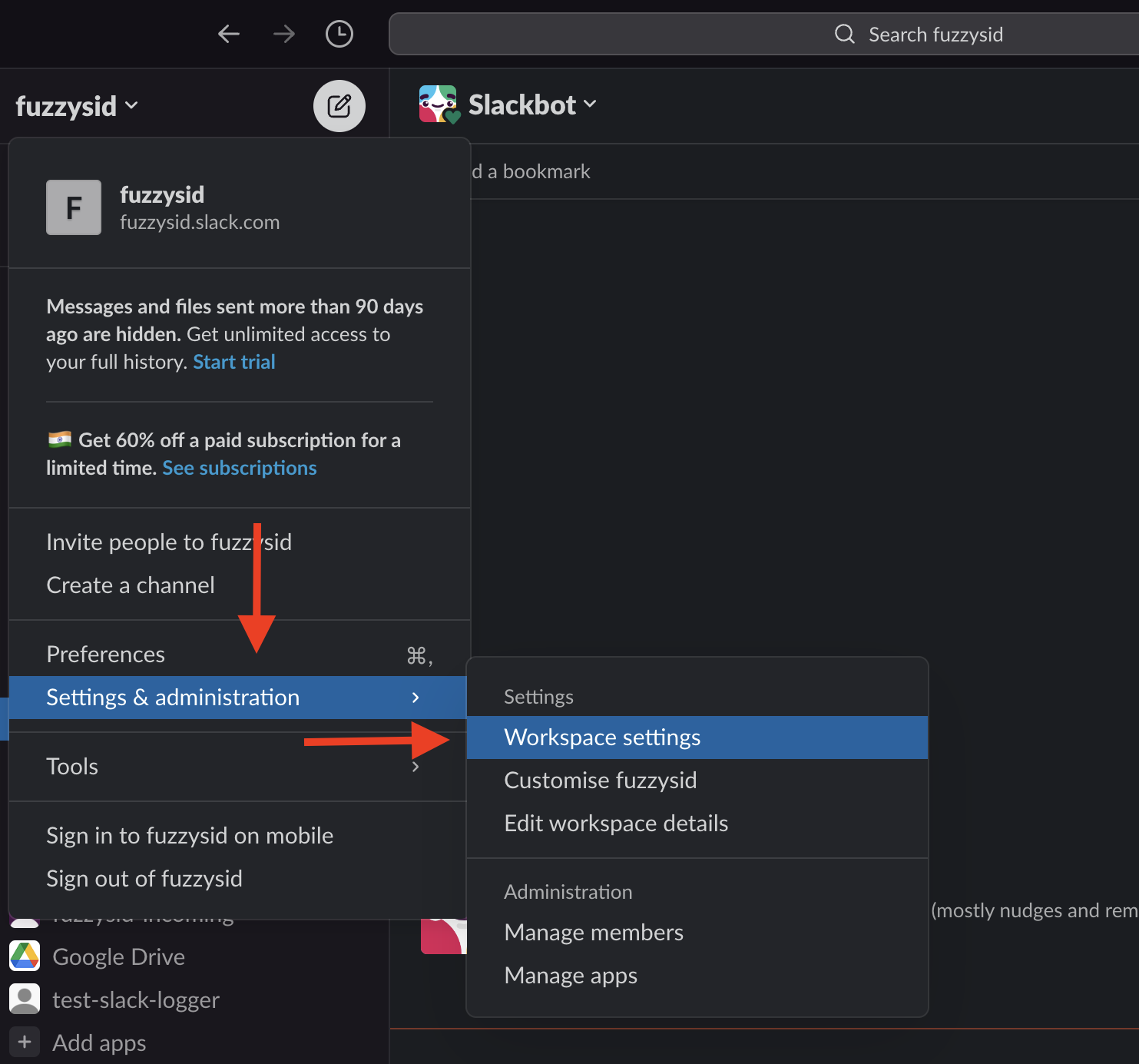
Slack should open an external link for your workspace settings page.
Export Slack Data
On the workspace settings page, click on the Import/export data option on the right side:
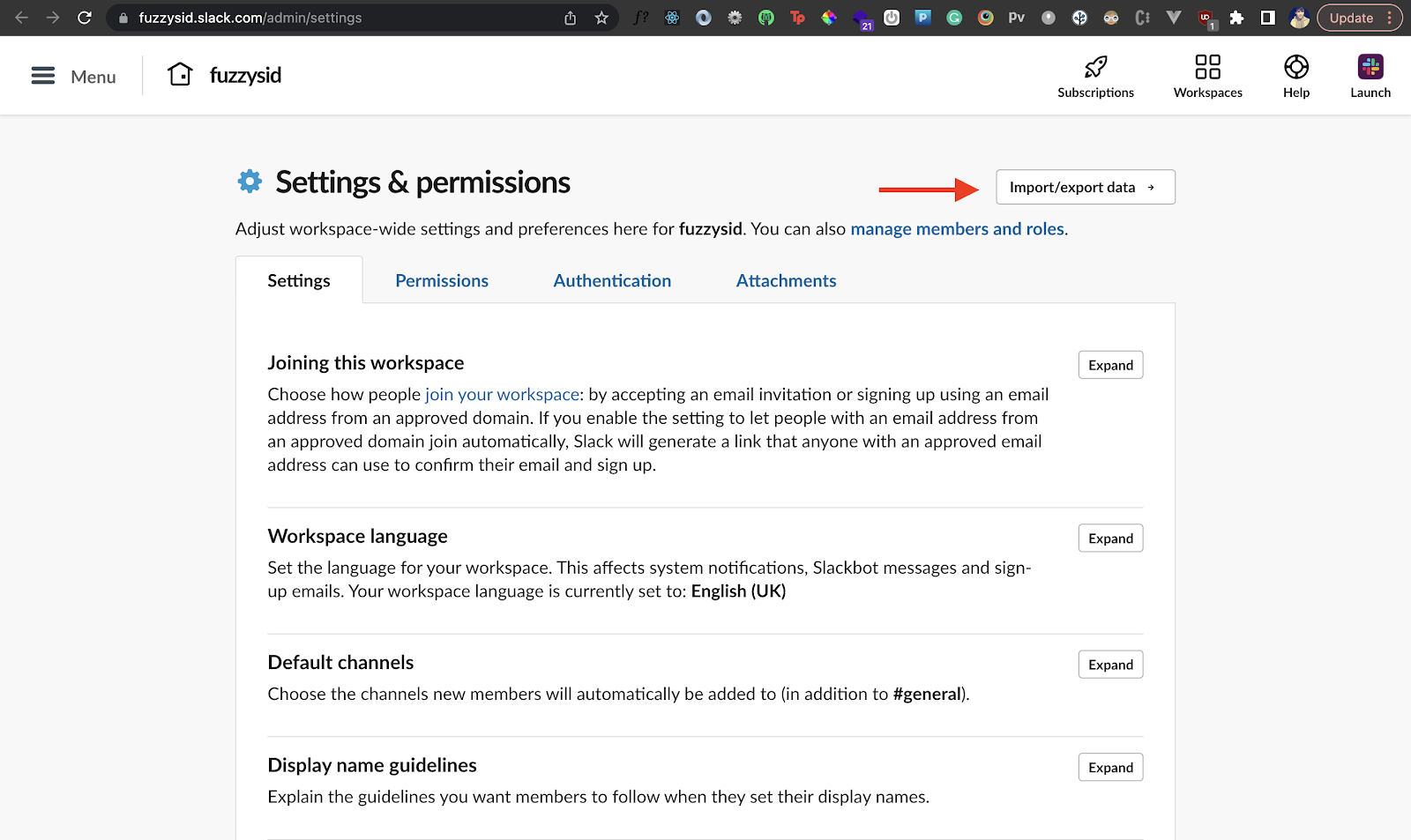
That should open the Import and Export tabs. Since we need to export data, choose the Export tab:
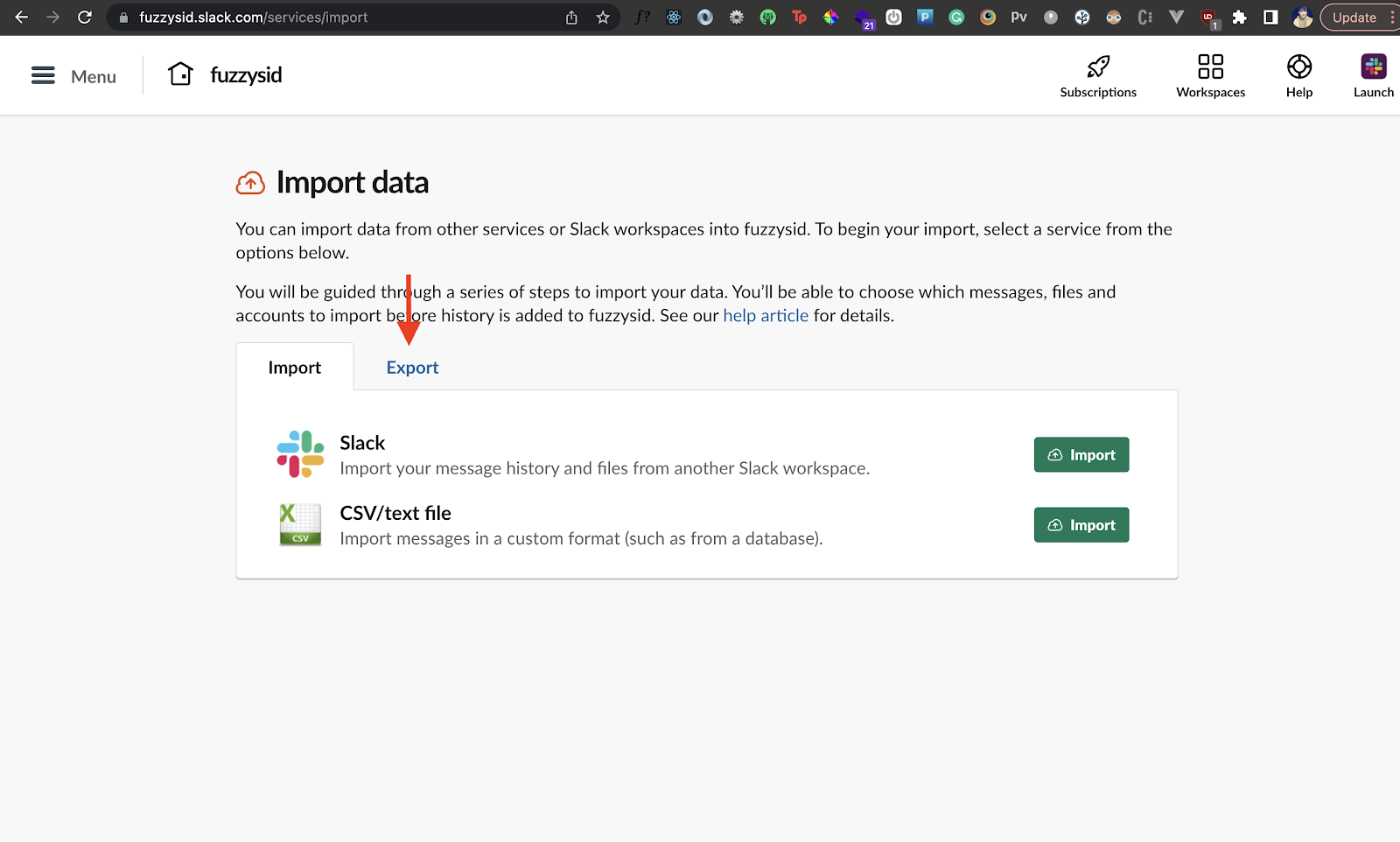
Next, choose an export date range. We'll select the last seven days here. Then, click on the Start export button:

Once you do that, your exported data will be shown right underneath that section. It may take a few minutes for Slack to generate your data.

You'll also get a confirmation email when the export is completed:

Once you download the exported file, you'll see logs pertaining to your users, channels, and messages. All the information pertains only to public channels. So if you have any private channels in your workspace, that data will not be exported.
How Slack Data Logs Can Be Useful
Anything related to your Slack history is exported in your Slack chat and activity logs. You can use this information to track older conversations that can help you reference data related to a certain event. Let's say you wanted to check how many members took an optional holiday last year on a specific date. If this information was present in a public channel, it can be easily retrieved from these exported logs.
Any important links or files and other information shared can also be retrieved via these logs.
View and Export Analytics
Analytics can help you understand the usage of your workspace in depth. Let's explore how you can view and export analytics for your Slack workspace.
Permissions Tab in Workspace Settings
From inside your workspace settings, open the Permissions tab:
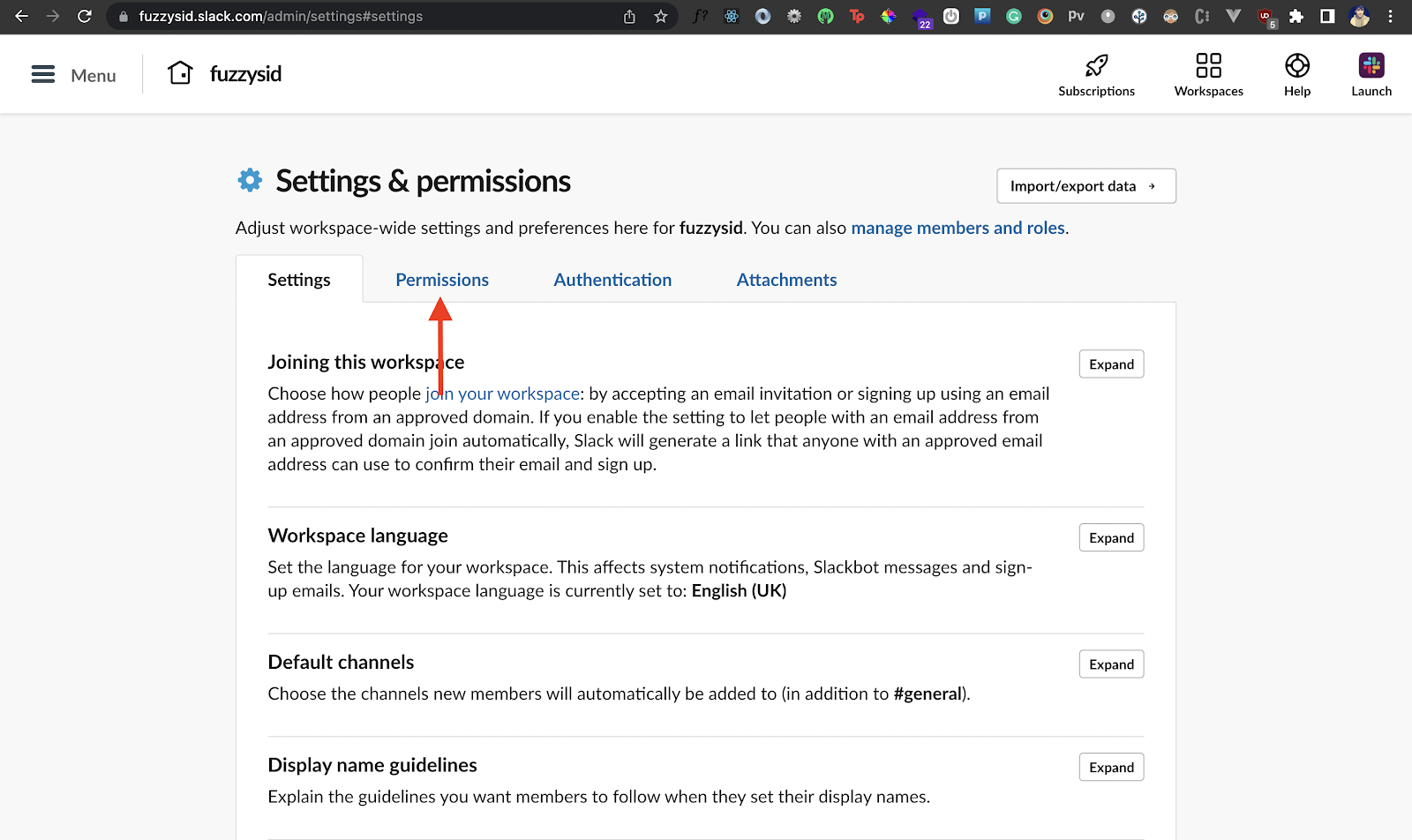
Scroll down to the Workspace analytics section:

That should take you to the analytics page.
The Analytics Page
You should see an analytics dashboard as shown below. By default, it shows data pertaining to the last 30 days, but you can change this using the dropdown on the top right inside the Overview tab.
Notice how it makes consuming all the information about your workspace visually convenient using charts and graphs. Slack logs information like the number of messages exchanged, the amount of file storage used, and any third-party apps or integrations installed.
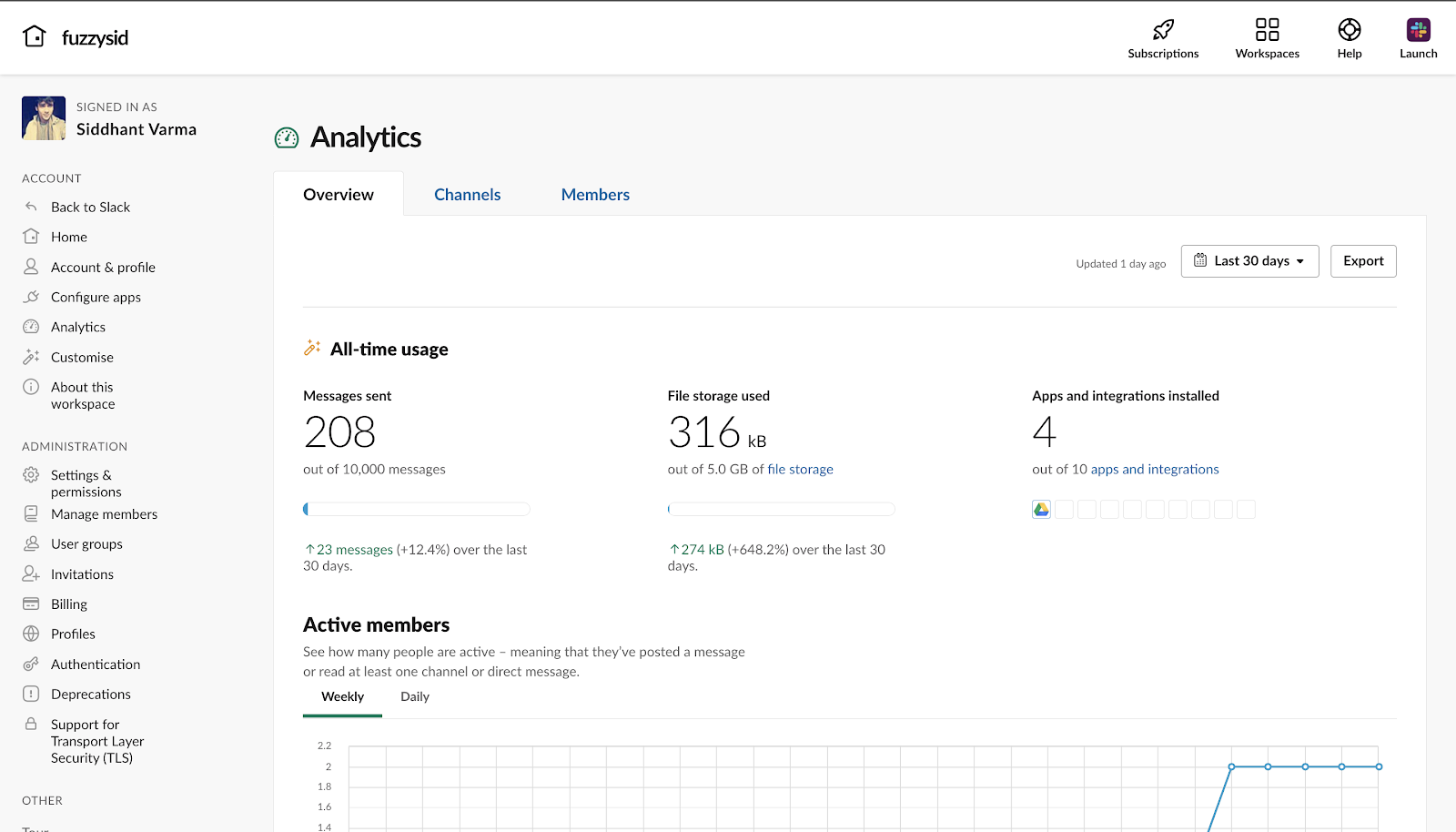
But that's not all. If you scroll down, you should see graphs that tell you how many members were active and the most commonly used public and private channels.

You can also switch to the Channels and Members tabs to see separate analytics related to your Slack members and various channels you have in your workspace. Note that you'll need a premium Slack plan to do so.
Export Analytics Logs
In the top-right corner of the Overview tab, you should see a button to export these analytics:

Once you click that, a CSV file with all the analytics logs and information will be downloaded on your device:

How Slack Analytics Logs Can Be Useful
Slack's analytics logs are the quickest and easiest way to understand how your team engages in your workspace. You can use them to figure out which channel is most active or which members are most prompt in communication, and also track how much Slack storage you're consuming.
View and Export Slack Access Logs
The more you trust Slack with your data, the more cautious you have to be in terms of hackers. Access logs are a way to ensure that you know who's signing in or out of your workspace, when, and from which device. Here's how to view and export the access logs for your workspace:
Go to Your Account Settings
From the Slack app, click on your profile picture in the top-right corner. That should open a small menu where you can select the Profile option:

Next to the Set a status button, click on the triple dots. That should open another menu with an Account settings link. Click on this link.

View Access Logs
The Access logs page should be available in the top-right corner of your account settings page:
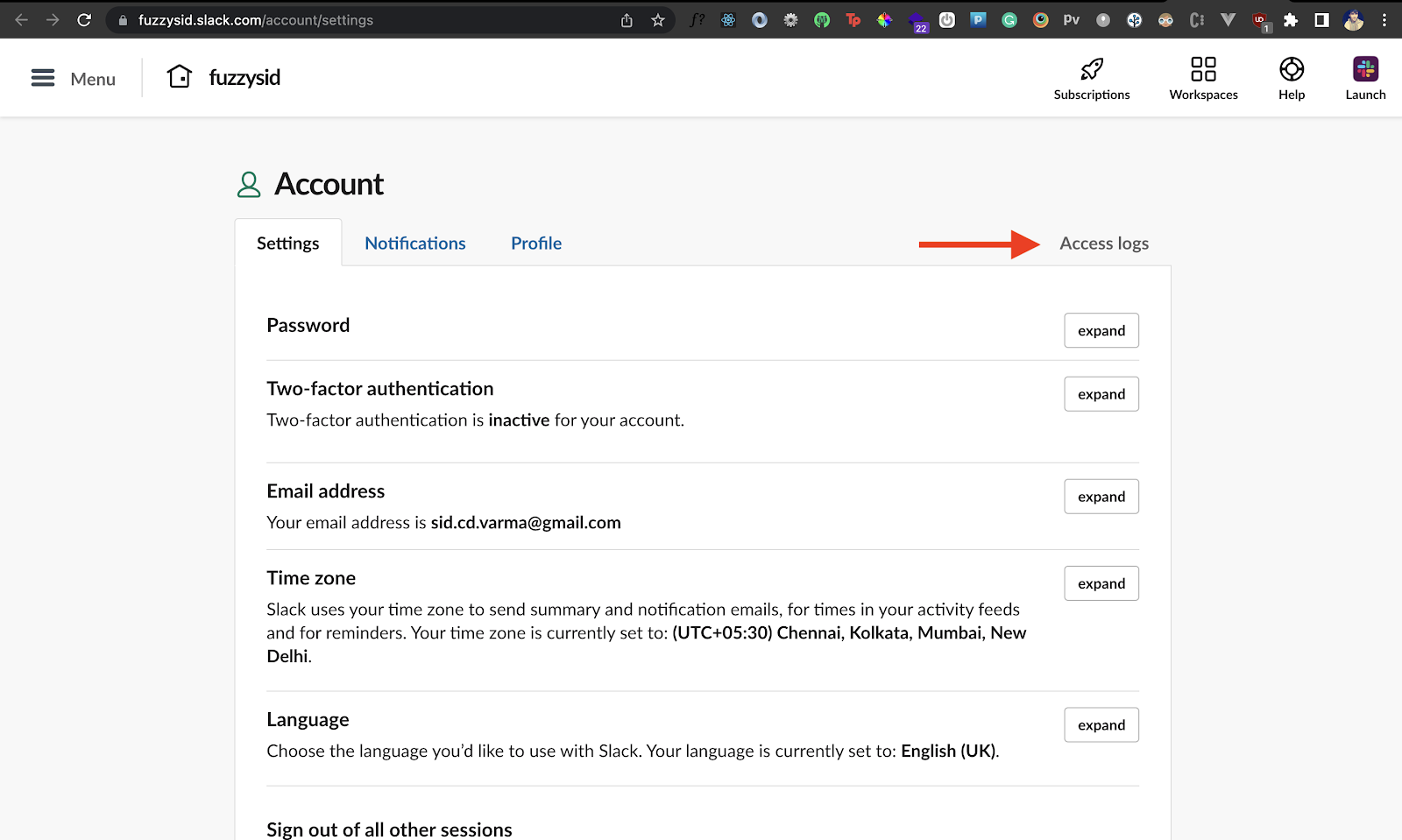
When you click on it, you should land on the Access logs page:

You can see the access logs for your own account here. Slack logs the time, device, IP address, and even network provider, along with the number of login sessions that were initiated during that period. Let's now go ahead and download these access logs.
Download Access Logs
Right above your access logs, you should see a Download access logs button:
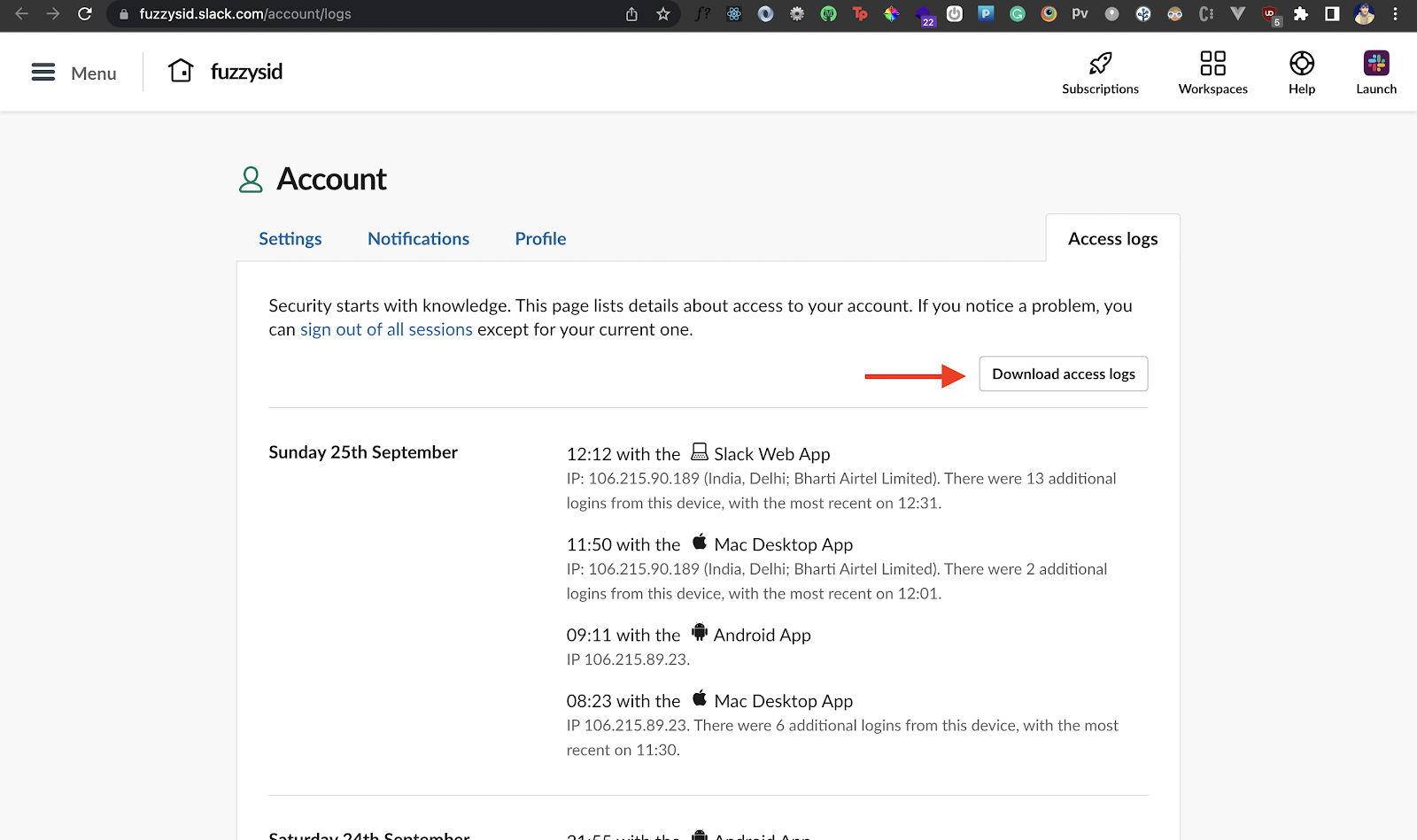
When you click that, all your access logs will be downloaded in CSV form:

Now you have all your access logs together that you can analyze in Excel.
How Slack Access Logs Can Be Useful
Security comes first, and access logs allow you to check any suspicious logins to your account. It also offers a quick logout of all device actions that you can trigger from your access logs page if you smell something fishy. In large enterprises and organizations, this can be extremely helpful from a security standpoint.
A lot of people don't review access logs in their workspace. Even when you're confident that a breach or hack is unlikely to happen, knowing where to find your access logs, and how to review them can help you confirm your workspace is secure.
View and Export Members and Roles Logs
Slack logs information specifically related to the members in your workspace and what privileges they can access. Let's see how you can look at these logs and export them.
Manage Members Page
Go back to your workspace settings page and click on the manage members and roles link:

That should bring you to the Manage members page:

Here you can see all the members in your workspace. Moreover, you can filter them based on their account type, billing status, and authentication.
Export Member List Logs
Right above the filters, there is an Export member list button:

Once you click that, your Slackbot should send you a direct message with the CSV file to download:

How Member List Logs Can Be Useful
By looking at these logs, you can prompt your members to use 2FA for authentication if they're using a traditional email and password. That can be helpful against hackers who might try to break into your workspace via your members' accounts. You can also glance at the CSV of member list logs to check the bots in your workspace:

Any bots or members you don't recognize may have jumped into your workspace to steal sensitive information.
Managing Slack Workflows
We've learned that information or logs in Slack can be helpful in many ways. If this topic is important to you, Slack is probably a big part of your day-to-day workflow. You can extract even more value and efficiency from Slack by leveraging a tool like Wrangle, a workflow automation and ticketing application that is built for Slack.
Wrangle allows your teams to build and manage custom workflows to align their tasks and dependencies. For example, Wrangle can help you manage complex processes like IT ticketing, budget approvals, employee onboarding, procurement requests, marketing reviews, and more in your Slack channels. Your Slack users simply type /wrangle, select a workflow, and the process begins. Wrangle provides powerful reporting and auditing so that there’s always a log of the decision making chain. It's the fastest way to get things done without leaving your most effective communication channel, and you can sign up for the freemium plan to create workflows in your Slack workspace.
Add Wrangle to your Slack workspace or schedule a demo!
This post was written by Siddhant Varma. Siddhant is a full stack JavaScript developer with expertise in frontend engineering. He’s worked with scaling multiple startups in India and has experience building products in the Ed-Tech and healthcare industries. Siddhant has a passion for teaching and a knack for writing. He's also taught programming to many graduates, helping them become better future developers.

- Try Wrangle free for 14 days
- Turn messages into trackable tickets
- Build a scalable help desk



Turn Slack into a productivity powerhouse with Wrangle
Create a scalable helpdesk in Slack. Automatically turn messages into trackable tickets and provide faster, more transparent service to your colleagues and customers with Wrangle — Try it free!






